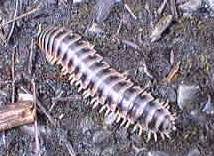

On the radio this afternoon a disembodied voice spoke of Christmas:
Christmas ceased being Christmas when we stopped giving presents and began
giving gifts. 
25,000 books in stock! All New! No book more than three dollars! Ever
wonder what happens to a supermarket when all the food has been sold? Sometimes
the shelves are re-stocked. Other times the market is converted to a book
warehouse--the bare shelves are stocked with all the books returned from
prior engagements at Tattered Cover, Waldenbooks, Bookstacks, and they
are sold for fifteen cents on the dollar. They're all new all right, as
opposed to used that is, but they're not really *new* if you know what
I mean. Nor are they inventoried or catalogued--its impossible to find
anything in particular, the clerks have only a vague idea if any particular
title is available. So you just kind of wander around waiting for something
to leap off the shelf. Paul Theroux (Riding The Iron Rooster, Mosquito
Coast) has been one of my favourite authors over the past few years
of reading about the travels of others so when his My Secret History
jumped off the table at me I knew I had one to buy even if the clerk found
nothing from my reading list. But then I thought if an author's books show
up in a bookstore like this they cannot be doing too well in the prime
time stores. 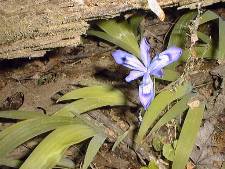
Dahlonega Georgia is the site of the first major U.S. gold rush and it is famous for its fried chicken and Southern country cooking. John and Farris host the Royal Guard Inn, a B&B in the Scandinavian style. He's Dutch, she's Norwegian, and she bakes a mighty mean chocolate cake.
John said that his wife didn't make English walnut chocolate cake for the guests but if I didn't mind his smoking we'd have coffee together on the porch. --What do you take in your coffee?, he asked.
--Baileys!
Ferris had gone to the meeting of her women's club and if John cut the cake just so she'd never notice the slice was missing. --That's ok John, as long as I don't inhale then chocolate cake has no calories. The house was built in 1938 by the wife of a doctor who'd recently died. The Vanderhoffs found it in 1990.
Just a block south of the B&B, is one of those famous chicken places where the same woman has been frying chicken for thirty years. And a block north is downtown where the original county court house is now a gold museum.
Gold was discovered in the region by Benjamin Parks while deer hunting in 1828. A census of the area prior to the onset of gold fever indicated about 224 whites, mostly trappers and missionaries, lived among Cherokee. A year later there were 15,000 miners pushing the Cherokee nation out. The Trail of Tears was a direct result of this gold rush. The name Dahlonega is taken from the Cherokee word da-lo-ni-ge-I which means "yellow" but was referring to the sulphurous colour of the rivers during periods of high water and not the gold.
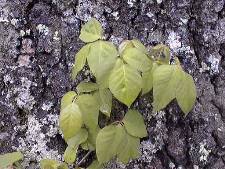
Observations from behind the wheel: Its more fun to drive behind the locals than in front. If you can keep up with them.
Last night over coffee on the porch John had asked me where I was bound and when I told him my next stop was Great Smoky Mountain National Park he went on to explain about taking U.S.441. I said I was planning on going north on U.S.129 but he said that way was so twisty and turny he'd had to put on a new set of tyres after driving that road once. --E'en if you drive only fifteen miles an hour yer tyres'll be a-squeelin' on e'ry curve. I'll just put the radio on one of those gospel stations, I said, and crank up the volume. --Maybe you'll be lucky and it'll rain.
U.S.129 between Topton North Carolina and Calderwood Tennessee has more
curves per mile than Miami Beach at Spring Break. The road climbs up through
the Cheoah Mountains and crosses Highland Gap. When the caution signs say
SLIDE AREA that means you're more likely to slide on the curves, especially
when they're wet. 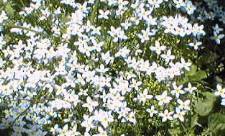
Tonight I'm camping, if you can call sleeping in the bed of a pickup truly camping, at C42, Cades Cove. Deer wander the spaces between the camping areas and there are reminders that feeding the bears can be hazardous to your health. Spring is still happening here, the new first green is still gold and some of the wild flowers have yet to bloom. The poison ivy is well underway however, I itch just walking past it. A tin of Beanie Weanies warmed on the exhaust manifold and a bottle of Corona cervesa sans lime but at least cooled by the A/C comprised my dinner.
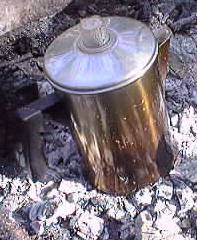 so I set about making a fire and rummaging through trunk and pack to see
what could be found for breky. Once upon a long ago I could light a fire
with one match but I am very much out of practice, this morning it took
me three. I could have done better with more preparation, better tools
(the metric socket set I bought from Sears to go with this little truck
has no woodsaw nor splitting maul) and dryer wood. I even resorted to scraps
of paper and a little motor oil before perk was achieved.
so I set about making a fire and rummaging through trunk and pack to see
what could be found for breky. Once upon a long ago I could light a fire
with one match but I am very much out of practice, this morning it took
me three. I could have done better with more preparation, better tools
(the metric socket set I bought from Sears to go with this little truck
has no woodsaw nor splitting maul) and dryer wood. I even resorted to scraps
of paper and a little motor oil before perk was achieved.
The Civil War ripped apart the quiet agrarian community of Cades Cove
like a sail in a storm; the end of that storm brought some relief but the
new century that followed brought new forces to bear on the lives of those
who lived here. Then in the late 1920's land appraisers came through buying
up farms for a national park. Ultimately the Cove lifestyle could not persist;
like the Cherokee before them the farmers were pushed out, responding to
larger forces that washed them along with the tides of time. 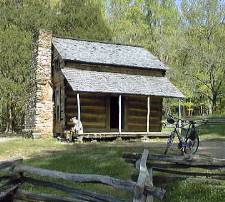
Around Cades Cove now is an eleven mile one way loop that visits some of the buildings that have survived or been restored by the National Park Service. Stop number ten is at the Elijah Oliver place where the Cades Cove tour booklet (published by the Great Smoky Mountains Natural History Association and excerpted here) describes the different styles of construction used and the arrangement of a farm. "Although `they all look alike,' there are notable differences in workmanship and use of wood material among these structures."
"Everything around you here speaks of an organic society, one living in and off of things that could be found or grown at home. The human settler that lived among these logs was almost as much a child of the forest as the other beasts. They pressed close to the breast of the earth and danced with the seasons far more than we. Like the beaver and the paper hornet, they built shelter from native woods. They and the bear robbed bee trees and berry bushes. They took live prey, as did other predators. These buildings merely refined man's life here. Rugged as it was, the pioneer at least understood the hows and whys of his existence. If a dough bowl split, he knew the cause lay in the seasoning of the wood, not in the miscalculation of some unknown plastics technician in a far away land."
After my bike around the loop, and lunch and a nap, Ruth from the neighbors in C45 came by to invite me to Saturday dinner: corn, beans, freezerslaw (Karen's recipe--slivered carrots, minced cabbage, red wine vinegar...) baked potato and Louisiana blackened marshmallows with perked coffee for desert. *They* know how to light a fire. (They've got some sort of clear liquid... not moonshine, but fire-water nonetheless...)
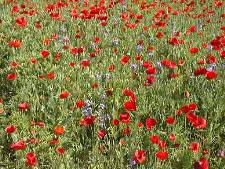
They've got some work projects along I40 that back up the traffic for several miles; somehow I missed learning about those back at the AAA office so yesterday I had plenty of time to contemplate my theory of twos and my theory of nines.
There are two kinds of people: those who, at the first sign of lane closure, get in the open lane. And the others who stay in the lane to be closed, passing signs Lane Closed Ahead one after another until they finally come to a barricade. There's a third set to this kind, those who race up the breakdown lane...
To offset the road-rage that festers and gurgles North Carolina has planted modicums of median and islands of interchange with an array of incredible wildflowers. Well Done North Carolina! More! More!
Kudzu Revisited, and reprinted, from On The Road Again September 1991 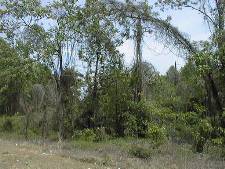
Another thing I want to know is has anyone done a formal study of how fast kudzu moves and what is filling out all those familiar shapes along the roads hereabouts. At one gravely intersection not on my map I pulled up behind a green '47 Pontiac who's driver, wearing a matching green sport coat, had an arm out the window signaling for a left turn. He was even wearing green gloves. There was nothing coming the other way so I couldn't quite figure what he was waiting for. When I went to pass him smoke-like tendrils from his green exhaust pipe grabbed at my front wheel and it was then I realised I was on the wrong road. Actually this stuff could be a good thing, it moves faster than grape vine and poison ivy put together, and look what its done for junk yards.

Mitch just returned from Vietnam where he had a silk robe made for me. It is of a more modest cut than the one I have been wearing and characters embroidered on the left breast tell of Life, The Universe, And Everything. There is a great dragon looping across the front and the whole thing is supremely colourful.
Bargain rate parking is to be found in New Market Virginia; ten cents for buys two hours at the meters on Main Street but the things for sale in the antique shops are hardly worth while. Some of the old silver seemed to be real enough, at least it looked like silver but without a stronger lens I couldn't be sure of the markings. In a display case were cap and ball revolvers, officer's swords, beverage flasks, from the Civil War. The flasks were made of stainless steel, the swords were stamped India, the revolvers had plastic parts tho they were mostly made of metal with wood grips. There were some fireworks too; California Bottle Rockets. But the fuses are on top. The instructions say Plant Firmly in Ground or Stand in Bottle, Remove Cap and Light Fuse. How do they go up in the air if you light the fuse from the top? California rockets are not really rockets but fountains on sticks.
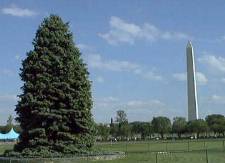
I've nothing much good to say about this place. The weather has been warm enough for standing around on hold at the few functional public phones I was able to find. The A/C in my little truck got more of a workout sitting in DC traffic in one day than in all the weeks I spent cruising the byways around Z'hills Florida--but that comment is not intended to be disparaging of the holey roads; only that if the District of Columbia put parking meters in the travel lane where everyone double parks they might be able to afford maintenance.
I'm staying at a private home in a gated guarded fenced adult community;
its about six miles northwest of the White House on the Chesapeake and
Ohio Canal bike trail, aka the Capital Crescent Trail in this neighborhood.
Great ride downtown, a bit of a headwind coming back but both ways beat
the traffic on Massachusetts Avenue. Every year I come here the traffic
is worse and this year its even worse than that. Half the mileage of the
city streets is under construction and the other half needs help so badly
that they really ought to stop what they're doing and fix them. But I had
a great time on the bike path going to the National Archives looking for
Oxtons. 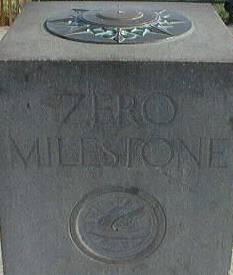
I was at Ground Zero today. This is the spot were all the ICBMs are aimed and where all the mileages on all the maps are figured from. Its right next to the National Christmas Tree on the Ellipse in front (back?) of the White House. The tree does not look nearly as big IRL as it does on the telly when they do the lighting ceremony. They must put the camera on the ground at some angle up to make it look taller.
My frustration with the telephone service is due to an inability to get any satisfaction venting my frustration. It seems there any number of overlapping territories here, complicated by layered service. You all know about that. Which long distance carrier--which local telephone service--who made the equipment--who maintains the equipment... Oh for the good old days of reliable, dependable regulated monopolies and penny postcards. Operators who answer to "0perator" at coin phones cannot assist the placing of coin calls cos they are long distance operators only (not that everywhere isn't long distance in Maryland, for every call--even to your next door neighbor--you have to dial ten digits) and local operators who answer to "211" are not really operators since they only want to hear about service problems and are not there to assist with placing calls (not that it matters since the instructions on the telephone's placard are in Spanish, Chinese, Kurdish). And to make matters worse the phone on the other side of the street is of a different area code-local company-manufacturer-preferred long distance provider... ^%^$%#$@! At least AT&T continues to let me use my credit card to call around the block or around the world. Thanks Roger for keeping my bill paid.
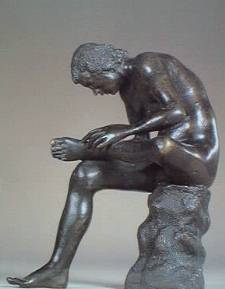
This is a fascinating place--a seat of power-a pit of hell, a sublime
feast of education and philosophy-a blatant excrement of waste greed despair...
The extremes of everything that comprise a community are on display on
the street, in the museums--the whole city is a museum, The Museum of the
American Way. A six-door limo waits at a traffic light while a man-of-the-street
retrieves some bit of jetsam to add to the items in his shopping cart of
everything; another man-of-the- street, this one carrying a sleeping bag
and pack low on one hip, picks a dead pigeon from the gutter in front of
a bus stop, passes it mysteriously behind his back from one hand to the
other and deposits it in a receptacle marked Recyclables. Huge belching
busses disgorge hordes of school children chittering the length and breadth
of the mall--in and out of the halls and across the grass and gravel, a
vast teeming sea of colour. 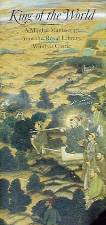
At the Arthur M. Sackler Gallery of the Smithsonian "King of the World" opened May 18th. This exhibition is certainly a must-see if you're in the District of Columbia this summer. (And if you're not in DC the exhibition will show in New York, Los Angeles, Fort Worth and Indianapolis over the coming year.) Set aside a morning. Large format magnifying glasses are provided (but sometimes they're all in use) to enable you to study the exquisite detail of these illustrations from the Padshahnama (Chronicle of the King of the World.) Shah-Jahan, who ruled the Islamic world, is most famous for building the Taj Mahal. This copy of the Padshahnama is on loan from the Royal Library, Windsor Castle by Her Majesty Queen Elizabeth II. The book has been unbound so the illustrated pages may be displayed in special frames on the wall along with explanatory text.
The roar of jets overhead intrude upon the burbling fall of water and
even mask the hammering of two stonemasons still engraving words in this
newest of America's memorials. 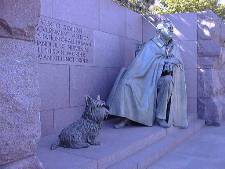
"The only thing we have to fear is fear itself" is perhaps the thing I remember most about FDR, certainly not that he spent his three terms as president in a wheelchair, but that fact was one of the greater contentions that has fueled the debate over this monument since it was proposed fifty years ago. Last week a heroic bronze FDR took its place between Lincoln and Jefferson on the banks of the Potomac, his chair all but hidden by the folds of a great cape. I was born at the end of FDR's second term--perhaps that's why I don't remember him in a wheelchair. Myself being transported in a chair or a pram it would not seem too unusual, eh? FDR also said --No country, however rich, can afford the waste of its human resources. Demoralization caused by vast unemployment is our greatest extravagance. Morally, it is the greatest menace to our social order.
Do you suppose that's true?
How can I belabour the state of the traffic except to say I can get around faster by bicycle--on the sidewalk. The strangest part of all is how some streets are reconfigured according to the time of day. A six lane road like Connecticut Avenue will be three or four lanes inbound (and no parking) in the morning, two lanes each way (and two lanes for parking) for a while, and then three or four lanes outbound (and no parking) in the evening. Before you pass someone, or even pull out to get around a car sitting under a No Parking sign, you need to read the Use 2 Lanes-Use 3 Lanes signs and check to see the time of day. Not the place for a casual tourist, nor even a serious tourist. Washington you are in too much of a hurry to go nowhere.
In the mail today this News From Palmer Station...
The Polar Duke is on her last voyage. Heading north to rendezvous with the "Ghoul" in Louisiana in order to transfer all the science equipment from the functional but no longer politically acceptable Polar Duke to the incredibly expensive and still under construction L. M. Gould. In this time of tight budget and massive cutbacks in science and support the NSF is constrained to cast off a ship well suited to the task and build a new one that right from the drawing board will be fraught with compromise. But she will be new, and she will be American.
The Long Term Ecological Research project was just renewed for another six years--still working on improving interactions but the positive news is that the data is getting out, so are the papers.
Walter and Marci write from Italy that ... after some hitchhiking, a bus ride, and 24 hours of ferry travel we arrived in Thessaloniki. If I was going to live in a city in Greece I would live there. Very cool town with a great archeological museum and lots of byzantine churches. It was nice because hardly any tourists make it that far north. It was only concerned with doing its own thing. We were tempted by the cheap train ride to Sophia, Bulgaria and took the plunge and headed still farther north.
These past few days I've been visiting with Amy and Jim Porter (OAE) in Alexandria Virginia. Just about as far out of town on the bike path as I was last week to the north, I am this week to the south. My hat's off to those OAEs who make home here and my thanks too for having the space and tolerance to accommodate my visit.
Rick, you may remember from an On The Road Again letter of a year or so ago, moves the PolarMail between the residents of the several Antarctic stations and their friends and family at home. Louise does PolarFlowers & PolarOtherThings. Over the past few years email has encroached upon PolarMail, the volume of traffic has reduced by a considerable degree, while at the same time the service Louise provides is receiving greater demand as Antarcticans find her personal attention to their requests for flowers and gifts outweighs the glitzy approach of the burgeoning industry of flowers by WWWeb. We missed one exit telling storeys to each other but didn't miss any potholes. Good thing Rick was driving his big truck, my little one would have been lost in some of those holes.
First stop, after asking directions twice, was at the news and library
office of the Wilkes-Barre Times Leader
which
holds the records of the Wilkes-Barre Record, which I guess was the papers
name in the old days. Actually I'd spend time the previous day on the phone
with the several state and county vital records centers and the newspaper
finding out where the records were in repose, scattered about as they are.
There was a courthouse fire sometime back in the old days that destroyed
all vital records prior to 1892 for birth and death, 1884 for marriage.
On top of that the surviving records held by the county of Luzerne go only
up to about 1905, the rest after that are with the state. 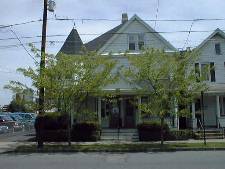
So the microfilm of the news paper seemed about the only thing left. We started scrolling through at December 1909, looking at the death notices on the last page of the Record and skipping ahead to the next day, and got to February 1910 after an hour. It was futile. I suppose that given enough time we would have found John Newton eventually but the library is open only two hours a day, three days a week. I wanted to cover some other bases just to see all that was available so we walked up the hill to one of two choices for 71 Maple Street and found a nice old house that could well have been there for Newton to rent. Along that walk we passed 8 West Jackson but the boarding house his widow ran in 1915 is now under Kings College Gymnasium. I took a picture of each and we headed back through two cemeteries. A private one had a keeper who told us he had no Newtons and the City Cemetery next door had no keeper but that is where we would find out later that Newton is buried.
Next along the way was the Luzerne County Courthouse and we found, upstairs in the registry of wills that John Newton left no will, and downstairs, in the sub-basement, learned for sure that he died after the state took over storage of the records. On to the Historical Society which had just opened now that it was after noon.
The guy who greeted us there was most helpful and took us straight away to the City Directories. (I find it fascinating that our society, our species even, has such a propensity for the keeping of records--you can find anything if you look in the right place. But that is the problem. It is only recently, genealogically speaking, that data is being stored on machines that make for easy access and retrieval. Older records are in books, inscribed with ink that has faded, on paper yellowed and crumbling. Some old records have been copied to microfilm to preserve and disseminate them.) We started at 1903 and found all the Newtons I knew about living together at 74 East North Street. There are a bunch of other Newtons in the city over this same time, perhaps three other families, and there is a History of Newtons on the shelf but all of them are prior to mine.
So then we jumped ahead to the Directory for 1915--no John, back to 1912--John's there, ahead to 1913--Bingo! Here was a line that instead of indicating John Newton's address and business stated that he died on April 7, 1913. Below that was an entry for his wife, heretofore invisible, that said Meta (wid of John) now lived at that same address. So now armed with a date we went back to the newspaper but since the Historical Society has all the same microfilm as the news library we didn't have to go far. They have a much better viewer too. It didn't take long now to find the death notice on the last page of the Record for April 8th 1913 and then at the bottom of one of the pages near the front of that issue about six inches of storey. Now the search turns to "Petticoat Lane" in London's Whitechapel district, where the storey says he was born, to find his parents.
After that arduous exercise it was time for lunch. Rick was driving and his seat belts got a good workout when I hollered STOP! as we were about to pass a fine old diner at 33 Wilkes-Barre Boulevard, in between a railroad station that looks like a bank and a brewery that looks like a boarding house.
Diners are my second favourite subject after commodes. Palooka's Diner at Wilkes-Barre has been on that spot for only fifteen years but has a rich history in the town of Exeter from where it was moved. That move would have been a sight--talk about Meals on Wheels. The diner is a monument to the 40s-50s cartoon character Joe Palooka who's creator is/was Wilkes-Barre native Ham Fisher. The character was a boxer famous during WWII and syndicated in almost every paper in the nation. Today the Palooka Diner acknowledges the genius of Fisher and his character. The diner is an authentic "Mountain View" diner, restored with modern facilities but true to the nostalgia of the 50s. Great place for a meal and good food too.
Psychiatrists say that 1 of 4 people are mentally ill.
Check three friends. If they're OK, you're it.
Stay Gold, bcnu, Love, ajo
A.J.Oxton, OA, OO, OAE, k1oIq

Back to ajo
Copyright © 2003, A.J.Oxton, The Cat Drag'd Inn , 03813-0144.![]()